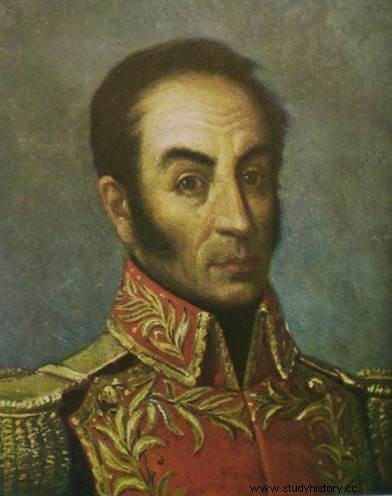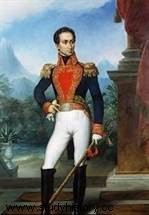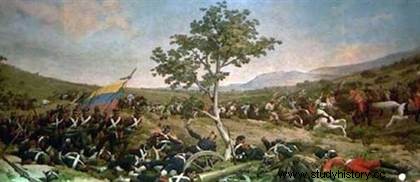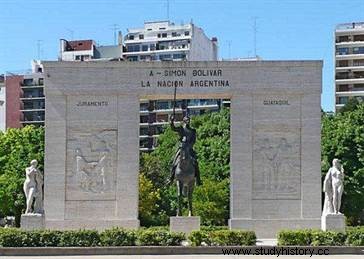 Mythical figure of Latin America , Simon Bolivar is the liberator of a large part of the South American continent from the Spanish yoke, which earned him the nickname "El Libertador". Subsequently, he was notably president of Gran Colombia (Venezuela, Colombia and Ecuador today) and gave his name to a new state, Bolivia. Hoping for the creation of a Pan-American confederation, he saw his political project fail at the Panama conference of 1826. Through the military exploits he accomplished against the Spanish armies and the important political functions he held in several countries South Americans, he nevertheless left an indelible mark on this continent, so much so that he acquired the status of hero.
Mythical figure of Latin America , Simon Bolivar is the liberator of a large part of the South American continent from the Spanish yoke, which earned him the nickname "El Libertador". Subsequently, he was notably president of Gran Colombia (Venezuela, Colombia and Ecuador today) and gave his name to a new state, Bolivia. Hoping for the creation of a Pan-American confederation, he saw his political project fail at the Panama conference of 1826. Through the military exploits he accomplished against the Spanish armies and the important political functions he held in several countries South Americans, he nevertheless left an indelible mark on this continent, so much so that he acquired the status of hero.
The troubled youth of Simon Bolivar
Simón Bolívar was born on July 24, 1783 in Caracas. He comes from a rich Creole family present in America since the 16th century. Many of his ancestors joined the colonial administration and his father belonged to the elite mantuanos – wealthy landowners. At the end of the 18th century, the Spanish Empire was experiencing a deep economic crisis, and had to make a movement of demands aimed at putting an end to Spain's commercial monopoly. Despite everything, for the moment there is no question of independence from the metropolis, even if revolutionary ideas are slowly beginning to spread in the South American continent.
 Coming from the social elite, Bolivar received, despite the premature death of his parents, a good education, although rather original. Undisciplined and unstable, the young Simon sees a succession of tutors. One of them played a particularly important role:Carreno-Rodriguez. This young reader of Rousseau introduced him to both classical literature and liberal philosophy until 1798. From that date, Bolivar was encouraged by his uncle to join the battalion of "white volunteers", an aristocratic corps of militia. It was the following year that he undertook a series of initiatory journeys in Europe, which would contribute to completing his training.
Coming from the social elite, Bolivar received, despite the premature death of his parents, a good education, although rather original. Undisciplined and unstable, the young Simon sees a succession of tutors. One of them played a particularly important role:Carreno-Rodriguez. This young reader of Rousseau introduced him to both classical literature and liberal philosophy until 1798. From that date, Bolivar was encouraged by his uncle to join the battalion of "white volunteers", an aristocratic corps of militia. It was the following year that he undertook a series of initiatory journeys in Europe, which would contribute to completing his training.
Travels of Simon Bolivar in Europe
After a brief stay in Mexico, Simon Bolivar arrived in Spain in May 1799. Hosted by his uncle close to the Queen, he witnessed the game of conspiracies around power before settling visit the Marquis of Ustariz, a cultured and refined man who introduced South Americans to reading and the arts. After some turmoil, he went to Paris where he took advantage of the theaters and shops before returning to Spain, where, testifying to his talent as a seducer, he married a young woman, who unfortunately died when Bolivar returned to America. Deeply bruised, he returned to the European continent, and increased his lavish spending in Paris.
In April 1805, while in Italy, he attended the coronation of Napoleon, a man he still admired at that time. Going to the Aventine, he is said to have exclaimed very lyrically about the decline and fragility of empires before continuing his journey to Holland, England and the United States, where he sees "freedom rational”. These multiple trips to Europe would have made him aware of the Spanish decline, and would have convinced him of the need for freedom.
From the first failures to the liberation of Latin America
The first uprising attempt in which Bolivar took part took place in 1811, when the vice-captain of Venezuela had just been replaced. With the support of the English, who have every interest in ensuring that the Spanish commercial monopoly disappears, Bolivar takes part in the insurrection in association with Francisco de Miranda, who has already been acting for several years in favor of independence. This was proclaimed on July 5, 1811, but this momentum was slowed down by the defeat of Miranda and Bolivar against loyalist forces.
 Exiled to New Granada, Bolivar returned to service and was assigned to the outpost of Magdalena. Disobeying orders, he plunged into the enemy lines to the West, seized Merida on August 7, 1813 and triumphantly entered Caracas:a second Republic was proclaimed, but its existence remained ephemeral. Faced with the growing violence and hostility that followed the conquest, Bolivar was forced into exile:the ephemeral glory was followed by a period of failures and fits of melancholy.
Exiled to New Granada, Bolivar returned to service and was assigned to the outpost of Magdalena. Disobeying orders, he plunged into the enemy lines to the West, seized Merida on August 7, 1813 and triumphantly entered Caracas:a second Republic was proclaimed, but its existence remained ephemeral. Faced with the growing violence and hostility that followed the conquest, Bolivar was forced into exile:the ephemeral glory was followed by a period of failures and fits of melancholy.
In 1818, Bolivar inaugurated a new tactic by landing in Guyana after having reconstituted an army. The events are then much more favorable to Bolivar, since a revolt in Cadiz prevents the loyalists from receiving reinforcements from the metropolis. With the capture of Bogota on August 10, 1819, then the battle of Carabobo (June 24, 1821) from which Bolivar emerged victorious, he acquired new legitimacy and was elected President of Colombia by 50 votes out of 57, a position he accepted against his will.
From 1823 to 1826, he was engaged in the Peruvian liberation wars, showing all his military talents:high mobility, tactician and use of guerrilla technique. But, faced with a rebellion in 1826, escaping assassination, facing a war against Peru in 1829, undermined by growing opposition, exhausted and ill, he resigned as president in 1830 after the declaration of independence of Venezuela. In disgrace, Simon Bolivar left Bogota in the mist and died in exile on December 17, 1830.
The Bolivarian Myth
A figure both challenged by his authoritarian practice of power but admired for his military exploits, Bolivar has become over time a political model on which different political currents have been built and was often reused by the rulers who succeeded him as a symbol of the fatherland. Thus, in Venezuela, where he appears as the Father of the Fatherland, a veritable state and popular cult is dedicated to the one to whom the title of . This phenomenon has tended to increase in recent years since the coming to power of Hugo Chavez, elected president of Venezuela in 1998, who triggered what he calls a “Bolivarian revolution”. He presents himself as his true heir, combining an authoritarian practice of power with Bolivar's idea of pan-Americanism - making Latin America one and the same state.
 This Bolivar cult has spread across much of South America, mainly Venezuela , and to a lesser extent in Colombia, as well as in all the countries he liberated, where statues in his likeness have been erected in many cities. The one who was given the title of Liberator was also able to serve as a model in Europe during the 19th century, for all the peoples who were fighting for their independence:Hungarians, Poles, Italians.
This Bolivar cult has spread across much of South America, mainly Venezuela , and to a lesser extent in Colombia, as well as in all the countries he liberated, where statues in his likeness have been erected in many cities. The one who was given the title of Liberator was also able to serve as a model in Europe during the 19th century, for all the peoples who were fighting for their independence:Hungarians, Poles, Italians.
Anchored in popular consciousness, the figure of Bolivar has also been conveyed by the plethora of literature dedicated to him, through poems and laudatory texts, which he whether it's Pablo Neruda or Paul Valéry.
Combining intellectual and physical vigor, inexhaustible faith in his convictions and periods of deep melancholy, liberal ideas and the authoritarian practice of power, Bolivar not only fascinated his contemporaries but undoubtedly marked the history and identity of a continent. Legitimately discussed for the cynicism and violence of some of his actions, praised in a sometimes almost religious way by literature, Bolivar is an ambiguous and complex personality. A myth was finally built around this character for several reasons:the liberation of part of Latin America from the Spanish yoke, his attachment to liberal ideas, but also the unfinished taste of his work, since he ultimately failed to put his pan-Americanism into practice.
Bibliography
-Pierre Vayssière, Simon Bolivar:The American Dream, Payot, 2008
- Simon Bolivar:The Liberator, by Gilette Saurat. Grasset, 1990.
- History of Latin America, by Pierre Chaunu. PUF, 2014.
